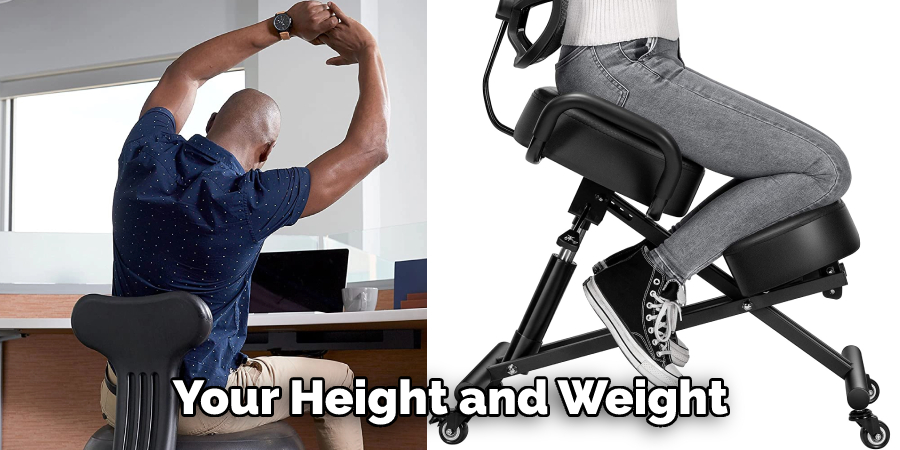If you are experiencing discomfort or pain from sitting at your desk all day, it might be time to ask for an ergonomic chair at work. Ergonomic chairs can help improve posture and reduce pain, making them a valuable tool for anyone who spends a lot of time seated. This article will discuss how to request an ergonomic chair at work and what to expect once you have one. Let’s get started!

We all know that sitting is the new smoking. We also know that many of us have no choice but to sit at a desk for eight hours (or more) every day. If you’re like most people, you probably don’t give much thought to your chair beyond whether or not it’s comfortable. But if you’re experiencing back pain, neck pain, or any other discomfort from sitting, it might be time to consider an ergonomic chair.
What Is an Ergonomic Chair?
An ergonomic chair is a type of chair designed to provide optimal support and comfort for the user. Ergonomic chairs are often adjustable so that the user can customize the chair to their body size and shape. They may also feature special cushioning or padding to provide additional support for the back, neck, and shoulders.
In addition, ergonomic chairs typically have various features that allow the user to adjust the chair to suit their own needs, such as height-adjustable seats and armrests. As a result, ergonomic chairs are an essential tool for office workers, as they can help reduce fatigue and improve productivity.
When choosing an ergonomic chair, it is essential to select a comfortable and supportive model while also adjusting to the individual user’s needs.
Why Do You Need an Ergonomic Chair at Work?
An ergonomic chair is designed to provide optimal comfort and support to the human body. The term ergonomic is derived from the Greek words “ergon,” meaning work, and “nomos,” meaning natural law or science.
An ergonomic chair aims to reduce the risk of injury or discomfort while working at a desk or computer. Poor posture and sitting in an uncomfortable position for extended periods can lead to serious health problems such as back pain, neck pain, and carpal tunnel syndrome.
If you are experiencing any discomfort while working at your desk, it is essential to speak with your supervisor about getting an ergonomic chair.
Does My Employer Have to Provide a New Office Chair?
Your employer is not legally required to provide you with a new ergonomic chair, but that doesn’t mean you can’t request one. If you believe that an ergonomic chair would help you perform your job duties more effectively, or prevent pain and discomfort, talk to your supervisor about your concerns.

Be prepared to explain why you need an ergonomic chair and how it will benefit you and the company. It may be helpful to do some research beforehand and have information about specific chairs or types of ergonomic furniture available.
If your employer is unwilling to purchase a new chair for you, there are other options. For example, you might be able to use a personal ergonomic chair if it meets the requirements set forth by your company’s office furniture policies. Alternatively, you could ask to modify your current chair to suit your needs better. For example, you might request a lumbar support cushion or an adjustable footrest.
No matter what route you take, stay polite and professional when requesting an ergonomic chair at work. You’ll increase the chances of getting the furniture you need to stay comfortable and productive on the job.
A Step by Step Guide on How to Request an Ergonomic Chair at Work
Step 1: Do Your Research About Office Chair Ergonomics
Before you start requesting an ergonomic chair from your employer, you must research office chair ergonomics. This will help you build a strong case for why you need an ergonomic chair at work.
Many resources are available online that can educate you about the importance of ergonomics in the workplace. The Occupational Safety and Health Administration (OSHA) website is a great place to start your research.
Step 2: Discuss Your Concerns With Your Supervisor or Manager
Once you have gathered some information about ergonomic chairs and how they can improve workstation comfort and productivity, the next step is to discuss your concerns with your supervisor or manager.

If possible, try to schedule a meeting to discuss your ergonomic needs at work. During the meeting, explain why you believe an ergonomic chair would be beneficial for you.
If your supervisor or manager is not open to the idea of providing an ergonomic chair for you, try asking if you can trial a chair for a week or two. This will allow you to show them how much of a difference an ergonomic chair can make.
Step 3: Write a Formal Request Letter
If your employer hasn’t already provided you with a form for an ergonomic chair request, you’ll need to write a formal letter. In your letter, be sure to include the following:
- Your name
- Your job title
- How long you’ve been employed at the company
- A detailed description of your current work set-up and how it’s impacting your health
- What type of ergonomic chair you’re requesting
- Why do you believe an ergonomic chair will help alleviate your symptoms
- Any other relevant information that will help your case
Once you’ve finished writing your letter, please send it to your direct supervisor or HR department. Make sure to keep a copy for yourself so that you have a record of your request.
Step 4: Follow Up With Your Request
If you don’t hear back about your request within a week or two, follow up with your supervisor or HR department. This will show that you’re serious about getting an ergonomic chair and willing to fight for what you need.
In some cases, your employer may not be able to fulfill your request right away. If this is the case, ask if there is any timeline for when they might be able to provide you with an ergonomic chair.
Thank them for their time, and continue following up regularly until you have a resolution.
The above steps will give you the best chance of successfully requesting an ergonomic chair at work. Remember to be patient and persistent, and don’t give up until you get the chair you need.
Benefits of Using an Ergonomic Chair at Work
An ergonomic chair is a type of chair designed to provide support and comfort to the user. Ergonomic chairs are often used in office settings but can also be beneficial for people who spend long periods sitting in a chair, such as those who work from home.

There Are Many Benefits of Using an Ergonomic Chair at Work. Some of These Benefits Include:
- Improved posture – An ergonomic chair can help to improve your posture by supporting your back and spine in a natural position. This can help reduce pain and stiffness in the back and neck area and fatigue.
- Reduced risk of injury – Using an ergonomic chair can help to reduce the risk of developing repetitive strain injuries, such as carpal tunnel syndrome.
- Increased comfort – Ergonomic chairs are designed to be comfortable to sit in for long periods. This can help to improve your productivity and concentration levels.
- Improved circulation – Sitting in an ergonomic chair can help to improve circulation by keeping your legs and feet in a natural position. This can reduce swelling and discomfort in the feet and legs.
If you think that an ergonomic chair would benefit you, talk to your employer about making a request. Many employers are willing to provide ergonomic furniture for their employees, but it is essential to complete the request so that they are aware of your needs.
Things to Keep in Mind When Purchasing an Ergonomic Chair
1. How Much Time You Will Be Spending in the Chair:
If you work at a desk for eight hours a day, five days a week, you will want to make sure that the ergonomic chair you purchase will be comfortable for that amount of time. On the other hand, if you only sit in the chair for a couple of hours each day, you may get away with a less expensive model.
2. Your Budget:
Ergonomic chairs can range from around $100 to over $1,000. It is essential to set a budget before beginning your search not to overspend.
3. The Type of Chair You Need:
The ergonomic chair you need will depend on your needs and preferences. Some people prefer chairs with armrests while others find them to be cumbersome. Some chairs recline, and those that do not. Choose the type of chair that you think will be most comfortable for you.
4. The Type of Activities You Will Be Doing While Sitting in the Chair:
If you plan to use your ergonomic chair for activities such as typing on a computer or reading, you will want to make sure that the chair is positioned so that you will not have to strain your neck or back. On the other hand, if you plan to use the chair for tasks that require more movement, such as crafting or painting, you will want a more adjustable chair.
5. Your Height and Weight:
Choosing an ergonomic chair that can support your height and weight is essential. If you are taller than average, you may need a chair with a higher back. If you are heavier than average, you will want to ensure that the chair can support your weight without tipping over.

When purchasing an ergonomic chair, it is essential to keep these things in mind to find the best possible option for you.
Are Employers Required to Provide Ergonomic Chairs?
In many countries, employers are required by law to provide ergonomic chairs for their employees, especially for those who spend a significant portion of their workday sitting down. Ergonomic chairs are designed to reduce strain on the body and minimize the risk of developing musculoskeletal disorders such as back pain and neck pain.
The specific requirements for ergonomic chairs vary depending on the country, industry, and job duties involved, but generally speaking, an ergonomic chair should be adjustable in terms of height, backrest angle, armrests, and lumbar support. It should also have a comfortable seat cushion, appropriate padding, and a breathable fabric cover.
In addition to providing ergonomic chairs, employers should also educate their employees on proper ergonomics and encourage them to take regular breaks and stretch their muscles throughout the day. Employers should also periodically review their ergonomic programs and make adjustments as necessary to ensure the health and safety of their employees.
How to Request a New Chair at Work?
If you’re experiencing discomfort or pain from your current work chair, it’s essential to bring this up with your employer and request a new chair. Before you request a new chair, it’s important to determine what’s causing the discomfort.
Once you know what’s causing the discomfort, you should research chairs that address your specific issue. Check with your HR department for any restrictions or guidelines for the type of chair you can request.
Next, schedule a meeting with your supervisor or HR representative and explain the problem with your current chair. Provide examples of how the discomfort impacts your work and productivity. Offer to bring in documentation from a doctor or physical therapist if necessary.
Finally, if your request is approved, follow up with your employer to ensure the new chair is ordered and delivered on time. If your request is denied, ask for an explanation and consider appealing the decision if possible. Taking these steps can improve your comfort and productivity at work.
Conclusion:
If you are experiencing discomfort or pain due to your current desk chair, it is essential to request an ergonomic chair from your employer. An ergonomic chair can help to improve your comfort and reduce the risk of developing long-term injuries. By following these simple steps on how to request an ergonomic chair at work, you can ensure that you are prepared to make a strong case for an ergonomic chair work.

